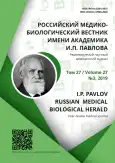有目的行为的生理性代价不同的人在动态内镜手术训练中的表现也不同
- 作者: Klimenko A.V.1, Pertsov S.S.1,2, Yakovenko I.Y.2, Levkin E.I.1, Samratov T.U.1, Gubenko M.S.1
-
隶属关系:
- A.I. Evdokimov Moscow State University of Medicine and Dentistry
- P.K. Anokhin Research Institute of Normal Physiology
- 期: 卷 27, 编号 3 (2019)
- 页面: 333-341
- 栏目: Original study
- URL: https://journals.rcsi.science/pavlovj/article/view/16341
- DOI: https://doi.org/10.23888/PAVLOVJ2019273333-341
- ID: 16341
如何引用文章
详细
目的:研究人类的活动结果的生理价值在外科手术训练模式下。
材料与方法:这项工作参与的87名年龄为18-24岁的男生。受试者被要求在Basic endosurgical simulation training and certification(BESTA)系统上进行一系列练习,并使用一个箱式模拟器T5 Large RM。每天进行10次训练,每次时间为30分钟。记录了错误的数量和操作的时间。在训练期间,在BIOPAC MP 36设备上记录了肌电图。在训练前后使用《VARICARD2.51》复合体进行心电图(ECG)登记及处理。在评估ECG数据时,使用了训练前后心率变异性谱分析的平均差异特征。
结果:结果表明,在有目的的活动过程中,高效的个体在进行运动时消耗的能量更少。无论其有效性如何,心理情绪应激状态下的目的行为都伴随着机体功能储备的耗竭。表现不佳的受试者表现出更明显的副交感神经(在观察开始时)和交感神经(在研究结束时)的减弱对心脏功能活动的影响。
结论:揭示了不同活动表现的人在内窥镜训练模式下目的性行为的生理支持特征。在该模型中,为了获得最佳的有目的活动效果,需要付出更大的生理代价。
作者简介
Aleksey Klimenko
A.I. Evdokimov Moscow State University of Medicine and Dentistry
编辑信件的主要联系方式.
Email: solidcid@mail.ru
ORCID iD: 0000-0002-0488-7871
SPIN 代码: 7207-5189
Assistant of the Department of Common Surgery
俄罗斯联邦, MoscowSergey Pertsov
A.I. Evdokimov Moscow State University of Medicine and Dentistry; P.K. Anokhin Research Institute of Normal Physiology
Email: solidcid@mail.ru
ORCID iD: 0000-0001-5530-4990
SPIN 代码: 3876-0513
Researcher ID: A-6697-2017
MD, PhD, Professor, Corresponding Member of RAS, Deputy Director for Science, Head of the Laboratory of System Mechanisms for Emotional Stress; Head of the Department of Normal Physiology and Medical Physics
俄罗斯联邦, MoscowIgor. Yakovenko
P.K. Anokhin Research Institute of Normal Physiology
Email: solidcid@mail.ru
ORCID iD: 0000-0003-2082-7171
SPIN 代码: 3111-8971
MD, PhD, Professor, Head of the Department of Common Surgery
俄罗斯联邦, MoscowEugene Levkin
A.I. Evdokimov Moscow State University of Medicine and Dentistry
Email: solidcid@mail.ru
ORCID iD: 0000-0003-0119-1673
SPIN 代码: 3474-5034
MD, PhD, Associate Professor of the Department of Common Surgery
俄罗斯联邦, MoscowTimur Samratov
A.I. Evdokimov Moscow State University of Medicine and Dentistry
Email: solidcid@mail.ru
ORCID iD: 0000-0001-6994-7188
SPIN 代码: 5864-9418
MD, PhD, Assistant of the Department of Common Surgery
俄罗斯联邦, MoscowMarina Gubenko
A.I. Evdokimov Moscow State University of Medicine and Dentistry
Email: solidcid@mail.ru
ORCID iD: 0000-0001-5439-9713
Student of the Department of Medical Faculty
俄罗斯联邦, Moscow参考
- Anokhin PK. Izbrannyye trudy: Kibernetika funktsional’nykh sistem. Moscow: Meditsina; 1998. (In Russ).
- Sudakov KV, Umryukhin PE. Sistemnye osnovy emotsional’nogo stressa. Moscow: GEOTAR-Media; 2010. (In Russ).
- Lapkin MM. Individual'nye osobennosti zhivotnykh i cheloveka v sistemnoy organizatsii tselenaprav-lennogo povedeniya. VI Pavlovskiye nauchnyye chteniya, posvyashchennyye 160-letiyu so dnya rozhdeniya I.P. Pavlova. Ryazan; 2009. P. 21-39. (In Russ).
- Medelyanovskiy AN. Funktsional’nye sistemy obespechivayushchiye gomeostaz. Funktsional’nye sistemy organizma. Moscow: Meditsina; 1987. P. 77-103. (In Russ).
- Zorin RA, Lapkin MM, Trutneva EA, et al. Physiological Costs Can Predict Effectiveness of Cognitive Activity. Doctor.Ru. 2012;10(78):24-8. (In Russ).
- Dzhebrailova TD, Sulejmanova RG, Ivanova LI, et al. Physiological Processes Underlying Purposeful Activity in the Students During Computer Testing. Journal of New Medical Technologies. 2013;XX(1): 38-42. (In Russ).
- Lila NL, Sudakov SK. Method for Studies of Orientation and Exploratory Behavior in Humans. Effects of Emotional Stress. Bulletin of Experimental Biology and Medicine. 2018;165(3):394-6. (In Russ).
- Fudin NA, Vagin YuE. Sports activity in functional systems theory. Sechenov Medical Journal. 2016; 3(25):34-45. (In Russ).
- Gorshkov MD, Sovtsov SA., Matveyev NL. BESTA, kurs bazovogo endokhirurgicheskogo simulyatsion-nogo treninga i attestatsii. Al'manakh instituta khirurgii im. A.V. Vishnevskogo. 2017;(S1):600-1. (In Russ).
- Simulyatsionnoye obucheniye bazovym navykam v endokhirurgii. Simulyatsionnyy trening po maloinvazivnoy khirurgii: laparoskopiya, endosko-piya, ginekologiya, travmatologiya-ortopediya i artroskopiya. Moscow: ROSOMED; 2017. P. 71-132. (In Russ).
- Hogle NJ, Liu Y, Ogden RT, et al. Evaluation of surgical fellows' laparoscopic performance using Global Operative Assessment of Laparoscopic Skills (GOALS). Surgical Endoscopy. 2014;28(4):1284-90. doi: 10.1007/s00464-013-3324-6
- Sloan DA, Donnelly MB, Schwartz RW, et al. The Objective Structured Clinical Examination. The New Gold Standard for Evaluating Postgraduate Clinical Performance. Annals of Surgery. 1995; 222(6):735-42.
- Dimirtiev DA, Saperova EV. Heart rate variability and blood pressure during mental stress. Russian journal of physiology (formerly I.M. Sechenov Physiological Journal). 2015;101(1):98-107. (In Russ).
- Kotel'nikov SA, Nozdrachev AD, Odinak MM, et al. Variabel'nost' ritma serdtsa: predstavleniya o mekhanizmakh. Fiziologiya cheloveka. 2002; 8(1): 130-43. (In Russ).
- Heart rate variability. Standards of Measurement. Physiological Interpretation and Clinical Use. Task Force of the European Society of Cardiology and the North American Society of Pacing and Electrophysiology. Circulation. 1996;5(93):1043-65.
- Babunts IV, Miridzhanyan EM, Mashayekh YuA. Azbuka analiza variabel'nosti serdechnogo ritma. Stavropol: Printmaster; 2002. (In Russ).
- Lutsevich OE, Rubanov VA, Tolstykh MP, et al. Faktory, vliyayushchiye na skorost' formirovaniya bazovykh manual'nykh navykov v laparosko-picheskoy khirurgii. Moskovskiy khirurgicheskiy zhurnal. 2017;3(55):47-53. (In Russ).
补充文件







